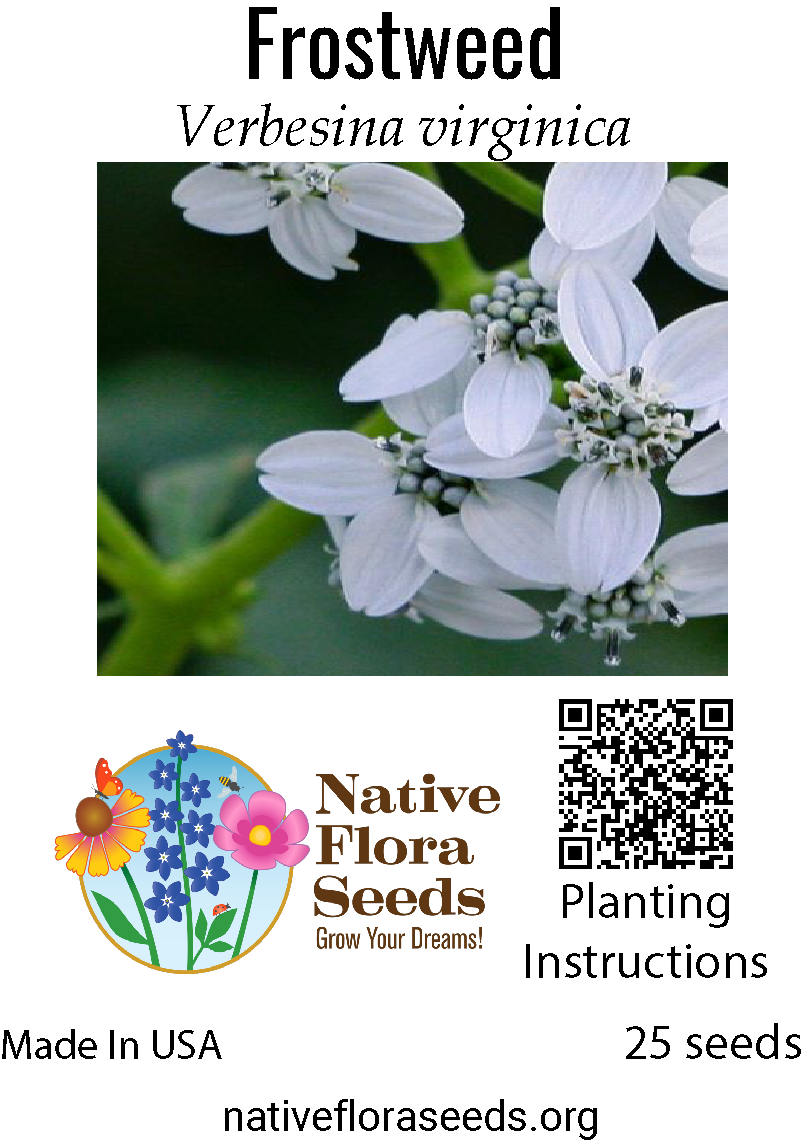Frostweed
Planting Instructions
🌼 Overview of Verbesina virginica (White Crownbeard / Frostweed)
Native Range: Eastern and Southeastern United States
Life Cycle: Perennial
Height: 3–7 feet tall
Bloom Time: Late summer to fall (August–October)
Ecological Value: Attracts bees, butterflies, and other pollinators
Special Feature: Known for "frost flowers" — delicate ice ribbons that form at the base of stems in freezing weather
🌱 Sowing Options
1️⃣ Direct Sowing Outdoors
Best Time to Sow:
Fall (ideal): Allows for natural cold stratification and spring germination.
Early Spring: Also possible if seeds are pre-stratified (see below).
Site Selection:
Sunlight: Prefers full sun to partial shade (at least 4–6 hours of sun/day).
Soil: Adaptable to many soils but prefers moist, well-drained soils.
Performs well in woodland edges, prairies, meadows, rain gardens, and disturbed areas.
Soil pH: Tolerates a range, from slightly acidic to neutral (6.0–7.0+)
Soil Preparation:
Loosen soil 6–8 inches deep.
Remove weeds and rake smooth.
Enrich poor soil with compost if needed, but not required in moderately fertile soil.
Planting Depth:
Surface sow or press seeds gently into soil.
Seeds need light to germinate, so cover only very lightly (1/16 inch or less).
Watering:
Water gently after sowing.
Keep soil evenly moist until germination (may take 2–4 weeks or longer depending on weather and conditions).
Once established, plant is moderately drought tolerant but prefers occasional moisture.
Stratification:
Yes — Cold moist stratification improves germination.
Recommended: 30–60 days of cold stratification.
Fall sowing naturally fulfills this requirement.
For spring sowing: stratify seeds in moist sand or paper towel in the fridge for 1–2 months.
Scarification:
Not needed.
2️⃣ Starting Seeds Indoors (Spring Transplanting)
When to Start:
Start cold stratification 8–10 weeks before last frost.
Sow seeds 4–6 weeks before last frost date, after stratification period.
Growing Setup:
Use trays or pots with well-draining seed-starting mix.
Surface sow or lightly press seeds into soil.
Provide 12–16 hours of bright light daily (grow lights or sunny window).
Watering Indoors:
Keep soil consistently moist using misting or bottom watering.
Germination usually in 2–4 weeks after stratification.
Transplanting Outdoors:
Harden off seedlings for 7–10 days before transplanting.
Transplant after last frost into full sun or partial shade location.
Space plants 18–24 inches apart.
🔧 Maintenance Tips
Low-maintenance perennial once established.
Can grow tall and may require staking or support in rich soils or windy areas.
Cut back old stalks in late winter or early spring before new growth.
Will self-seed moderately, so deadhead if you wish to limit spread.
Excellent addition to pollinator gardens, native meadows, or naturalized plantings.
🚫 Invasiveness
Not considered invasive.
Can naturalize and self-sow, but spreads modestly and does not aggressively crowd out other native species.
Easy to manage with light maintenance or occasional thinning.



